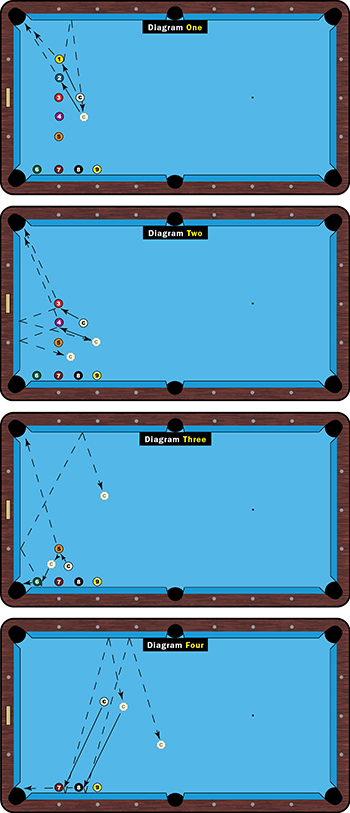Work on your cue ball control in tight spaces with this great drill.
Deft touch with the cue ball is such an important part of your game. Sometimes itís a good thing to practice a drill that focuses on cue ball control in tight spaces.
Hereís a tough drill where pocketing the balls isnít the big issue. The test is in maintaining control of the cue ball and if you want to build a good touch and learn to play in close spaces, this is the drill for you. Trust me, this drill will make you crazy at times, but itís very rewarding when you conquer it, and it will improve your touch and cue ball control in close quarters.
Again, this is a difficult drill, so take baby steps or you will get aggravated early. Getting to the 6 ball is a good effort, and improving your scores will keep you busy.
The setup for this drill is easy, and since the balls are so close together, itís easy to reset the positions if you miss.
Start with cue ball in hand (Diagram One). Youíll want to leave a slight angle, use the rail and try to get straight in on the 2 ball. No English required here, just high cue ball. Draw straight back off the 2 ball for position on the 3.
This is where things get a little tricky (Diagram Two). You canít bump other balls, so you need to find the gap between the 4 and 5 balls. This may be the toughest shot in the drill, so donít get frustrated if you mess this up. I usually play this high on the cue ball and with a touch of left English. It may take a few times to find that gap.
If youíve made it through, the shot from the 4 to the 5 also requires great touch. If you can squeeze between the 5 and 6 and land properly on the 5 ball, youíre past the toughest part of the drill. Use middle cue ball with a touch of left.

Going from the 5 to the 6 is really just a simple stop shot (Diagram Three), but you need to keep your focus because this is the home stretch and Iíve messed up these last four balls before.
Cue ball speed is important here. Use a high cue ball with a tip of right English. Go three rails for position on the 7.
Youíll run the cue ball across the table and back for the last two shots ó from the 7 to the 8, and from the 8 to the 9 (Diagram Four). On the 7 ball, itís important to not quit on the shot. You need to get the cue ball out high enough for the 8. I usually play this shot just below center with a half-tip of left. Donít decelerate on this shot or you will come straight back across and leave no angle for the 8.
From the 8 to the 9 you can let your stroke out a little more. Because the 9 is the only ball on the table, you can come in higher. Cue just below center with a half-tip of left. Again, focus on this shot. Donít get complacent because nothing is worse than messing up on the last ball. Trust me, I know!
Again, this drill requires great touch and cue ball control. You have to find the gaps and stay in line. Itís a great drill variation for these tight window shots on the rail.





